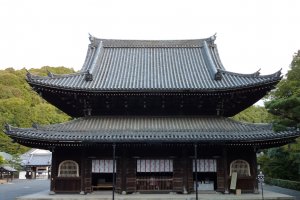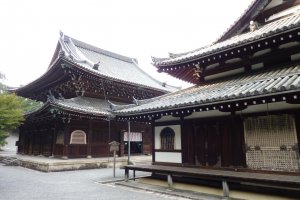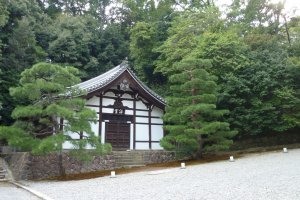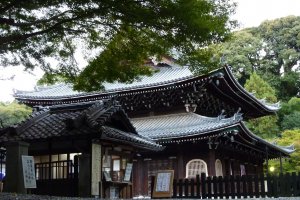Located on the slopes of higashiyama, Kyoto’s eastern mountains, Sennyu-ji temple might be a little bit hard to reach as it is off the main tourist tracks. Despite its lack of accessibility, it is a must see among Kyoto’s Buddhist temples. Surrounded by a dense forest, it is a secret well preserved, even from many locals, a haven of peace which contains more than twenty-five imperial mausoleums.
A simple but massive wooden gate west of the temple marks the frontier between the secular and the sacred world as your journey begins here with a short but steep climb. Turn right at the intersection and follow the main road to reach the temple's main gate (daimon).
Sennyu-ji, or the "temple of the gushing water", is said to have been founded during the 13th century by the illustrious monk Junjo. Sponsored by feudal lords and aristocratic families, he was allowed to build the first pavilions of what would become a flourishing Buddhist school during the next centuries. Burnt down almost entirely during the 15th century, most of the buildings were rebuilt in the mid-seventeenth century and still stand today.
After purchasing your ticket, start by heading left to reach a small pavilion, the yokihi kannon-do. You can admire a very rare statue of Kannon, the Buddhist goddess of compassion, brought back from China in 1255. It is said to have been carved to reflect the beauty of the legendary Chinese Empress Yang Guifei. Until 1955, this treasure used to be kept hidden and shown to the public only once every hundred years!
Turn left as you exit and follow the path down to reach the main hall (honden) and, behind it, the hall of Buddha’s relics (shariden). Both are heavily influenced by Chinese architecture. Feel free to enter the first one as it contains several treasures, including a rare set of gold-layered Buddha statues. The shariden, where a tooth taken from the historical Buddha’s relics is said to be enshrined, is unfortunately closed to the public except on special occasions. You can still enjoy its splendid curved tile roof, covered with a silvery sheen on rainy days.
Before entering the last pavilion of the temple compound, you should make your way to the right, behind the hall of relics. A narrow approach along the forest will lead you to an imperial mausoleum, one of a kind in Japan. Since 1242, fourteen Emperors and several other members of the Imperial Family have chosen to be buried here. Far from the city lights and bustle, this is probably when you will realise that you have not heard a sound for the last hour. And barely seen anyone…
You can then turn back and visit the imperial rooms (gozasho) if you wish. Used as a resting place by the Imperial Family since the 19th century, photographs, personal artifacts, pieces of art and folding screens are on display here. Tickets are sold at the counter and you will have to remove your shoes before entering. From mid-November to early December, the blaze of maple trees will paint the charming inner garden with vivid colours. Enjoy this moment of tranquility while sitting on the wooden balcony.
Often called Mitera, or The August Temple, due to its connections with the Imperial Family, Sennyu-ji is a witness to the passing of time like no other place in Kyoto. The superb architecture and unique atmosphere within an ever-changing city is a delight for the senses. Whatever the season, you will hardly ever forget the journey.
How to reach Sennyu-ji:
You can reach Sennyu-ji by cab from Kyoto station (10 minutes, ¥1000).
By train, take the JR Nara line from Kyoto station and get off at Tofuku-ji station (3 minutes, ¥140). It will be a 10 minute walk to reach the temple from Tofuku-ji station.
By bus, you can take line 208 from Kyoto station or 207 from Shijo kawaramachi (¥220). In both cases, take the East-bound bus (higashi-muki) and get off at Sennyu-ji michi. It will be a 7 minute walk from here to the temple’s gate.
If renting a car, there is a free parking area right in front of the temple’s main gate. It costs ¥500 to enter the temple and ¥300 more to visit the imperial rooms.



































